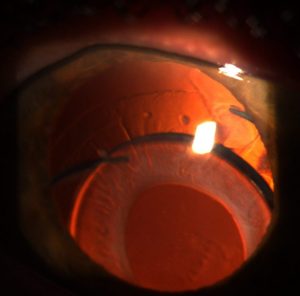Complicated surgery
Many factors affect the risk of complications in cataract surgery. Here are a few:
- Small pupil size
- Inability to lay still for 15-20 minutes (restless leg syndrome, obstructive sleep apnea, CHF, COPD, back pain, and others)
- Zonular laxity (increases risk of IOL dislocation)

- Small anterior chamber decreased workspace during surgery)
- Floppy iris syndrome (IFIS). Stopping alpha-1 antagonist therapy before surgery is not beneficial, but awareness of exposure and use of an iris retractor or pupillary (Malyugin) ring intraoperatively can help avoid complications. (See videos of iris retractors and Malyugin rings in action).
- Pseudoexfoliation syndrome (PXF) can lead to poor pupillary dilation, zonular instability leading to mobile or subluxed lenses that are difficult to remove, and corneal endothelial dysfunction that may increase corneal edema after cataract surgery.
- PXF is an age-related systemic microfibrillopathy that leads to gradual deposition of fibrillary particles from the lens and iris pigment epithelium onto the anterior lens capsule, ciliary body, zonules, trabecular meshwork, corneal endothelium, and iris. This also increases the risk of glaucoma. Gonioscopy can be used to detect pigmentation in the angle in this disease. Malyugin rings, iris retractors, and capsular tension devices for zonular support can be used during surgery to help prevent complications.
Pseudoexfoliation syndrome
- PXF is an age-related systemic microfibrillopathy that leads to gradual deposition of fibrillary particles from the lens and iris pigment epithelium onto the anterior lens capsule, ciliary body, zonules, trabecular meshwork, corneal endothelium, and iris. This also increases the risk of glaucoma. Gonioscopy can be used to detect pigmentation in the angle in this disease. Malyugin rings, iris retractors, and capsular tension devices for zonular support can be used during surgery to help prevent complications.
